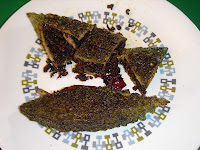Karela (Bitter Melon) is an Indian Vegetable which we have started to see in the UK Indian grocery stores. It is one of those Indian vegetables which is very much an acquired taste, you either love it or don't want to go anywhere near. I was in the second category till its recent resurgence in the UK. When I think about why I didn't like it as a child, it probably was because of it's looks. I would visualise it looking like a green mouse running around. Well it certainly doesn't run around, but as it's English name suggests it is bitter in taste, unless one uses lots of spices to mask the bitterness and then one starts to like it very much. This is what this recipe does very well.
Karela in India is alleged to have lots of medicinal qualities and recently there have been many articles about its benefit in treating Diabetes. Just as well then it is popular amongst the Indians who have one of the highest incidence of Diabetes.
Method:
Karela in India is alleged to have lots of medicinal qualities and recently there have been many articles about its benefit in treating Diabetes. Just as well then it is popular amongst the Indians who have one of the highest incidence of Diabetes.
Ingredients:
- Karela 4 pieces
- Dhaniya whole 1/4 cup full
- Sonf 1/4 cup full
- Kalonjee seeds (onion seeds) 1 TSF
- Whole Methi seeds 1 TSF
- Whole Jeera 1 TSF
- Shah Jeera 1 TSF
- Whole red chilli approx 1 TSF small size
- Mango Powder 2 table spoon
- Salt 1 TSF
- Onion 1 small
- Garlic Cloves 2 cloves
- Oil for cooking
- Dry roast Daniya, Sonf, Kalonjee, Jeera and Methi seeds in a frying pan.
- When above is almost roasted add Shah jeera and whole chillis and roast these as well for 1-2 mins.
- Put the above in a blender and make a powder. Add salt and Mango powder to the above and mix. This can now be kept as a fillings as ‘Kalongee’.
- Lightly scrape the Karela.
- Microwave the Karela for 5-8 minutes
- Take Karela out of the microwave and split open from the side (make sure you do not fully cut it into halves) and take the seeds out. Throw away the hard ones but the small soft seeds can be used for filling.
- Cut the onion into small cubes (just like preparing for making curry).
- Brown the onion in 2 table spoons of oil in a pan. When slightly brown add the crushed garlic. When both a lightly golden brown add the Kalonjee masala powder. If you have kept the soft seed from Karela you can crush and add these as well. Now fill the Karela with this stuffing and seal the Karela side with wet atta (flour) with salt. You can tie it with thread as well.
- Shallow fry the Karelas until brown on all sides (takes approx 10mins).
- Cut the Karela into 2 inch pieces for serving. This is best done hot at the time of serving.





